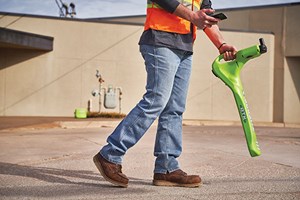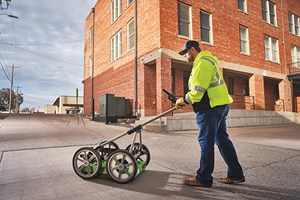August 2023 Vol. 78 No. 8
Features
Asset management: Digging data
Digitally mapping, documentation can aid compliance, improve profitability
by Cory Maker and Patrick Iyonsi
There are already lots of good reasons for why you should digitally document underground construction jobs, from pre-drill planning to post-drill reporting. It can help you better understand congested easements to avoid costly and dangerous cross bores. It can reveal how well – or poorly – operators are using the equipment. It can even improve how you bid for jobs by making sure bids reflect each job’s unique risks and challenges.
Now, you can add one more reason to the list of why you should document jobs – it will soon be required.
California’s Senate Bill (SB) 865 will require that all new subsurface installations in the state be “mapped using a geographic information system and maintained as permanent records of the operator.” While its activation has been delayed, when the bill does take effect, it will make California the first state to legally require the creation and preservation of maps for subsurface installations.
Other states are likely to follow suit and enact similar laws. Cities across the U.S. are also creating their own requirements, at the local level, to protect people and underground utilities.
At the same time, more bid specs are requiring that contractors provide electronic drilling records (EDRs) as part of a job. This involves logging specific data about your drills’ operating parameters during a job.
Collecting bore and equipment data may seem like added work. If you install fiber, you may worry that work will eat into tight profit margins that are common in the industry. But the truth is, you likely already have much of what you need to record the data. That data can do more than help you comply with new requirements – it can help you be more efficient and profitable.
Data is power

Forward-thinking contractors have gone all in on collecting and using data because they know it can help them work better.
For example, some contractors are using drill telematics to gain valuable insights into how machines are being used – or potentially misused. They can track the productivity of each machine to better plan workloads and monitor machine hours to plan maintenance in advance. And they can record machine duty cycles, fuel consumption and machine utilization to track costs and understand if operators are properly operating machines.
To gain a similar holistic view of your fleet and your job sites, you need three key data sets.
Planning data

First, you need data for your plan. A clear plan can help you create records for compliance purposes. It can also help you reduce risks and improve your productivity on the job.
Widely used utility-locating devices employ automatic, real-time data capture and integrated GPS to help locator crews accurately and reliably locate underground utilities. The latest versions of the devices, with enhanced receivers, even allow crews to locate utilities with centimeter-grade accuracy.
As the device locates utilities, it can map and label them as power, water or telecom, recording that information locally. Locator crews can then access the information from their smartphones and upload it to their mapping service, whether it’s a CAD system or Cloud-based mapping service. Crews can also send the information to their supervisors, owners or other parties for approval or further action.
Eventually, as more cities and states require mapping of underground utilities, crews will also be able to upload this information to an external Cloud-based system for statewide, or even nationwide, utility mapping.
What’s more, all this can be done using one device and one software – making the planning process simple and efficient. Because all data is recorded and managed digitally, rather than manually, it helps reduce the risk of errors.
Boring data
Second, you need data for your bore. Using an HDD guidance system, drill operators can download a bore plan and see it overlayed on their guidance display. This can help them stay on plan by monitoring critical waypoints as they drill.
The system also logs bore data in real time. While in the field, the drill operator can download this data to a smartphone, tablet or computer to review a profile of the drill and compare it against the plan.
At the same time, on-board equipment telematics can record equipment operating data to help contractors meet EDR requirements and stay productive. The data can show, for example, how a drill is being utilized, how long its engine has been idling, and if it is being misused or overused.
Telematics data can also include valuable equipment diagnostics to help minimize machine downtime. Operators onsite can monitor fuel and DEF levels, battery performance and other systems. Fleet managers back in the office can track wearable and service parts to understand how quickly operators are going through drilling bits or digging chains.
Reporting data
Third, you need data for your report. After a job is done, the HDD guidance system can generate an as-built report. You can store the report, along with the plan, for compliance purposes and to resolve any potential disputes in the future about the bore.
Again, because data logging in the as-built report is digitally automated, it can reduce errors compared to handwritten bore logs. Automated documentation can also help you expedite the payment process. Instead of waiting weeks or even months for paper-based payments to process, you can possibly get paid the same week you complete a job.
You can also store equipment telematics data and use it both for EDR reporting and to help you better plan for jobs. You can monitor, for example, how each machine in your fleet is performing. You can look for patterns in idle hours to help schedule preventive maintenance. Further, you can use historical jobsite data to better plan for future workloads and more accurately estimate hours for new jobs.
In one case, a company used equipment fuel-consumption data to realize that its machines were running idle for too long – costing the company upwards of $800,000 per year. Such discoveries can help you improve how operators run machines and realize big savings.
Bringing it all together
Data from technology that’s likely already in your fleet can help you work better at every stage of a job. It can help you efficiently identify and map existing buried infrastructure, plan and install new lines with confidence, and report as-builts and EDRs with ease.
However, just having bore and equipment data is not enough – you also must be able to integrate it. If the technologies that produce the data can’t share it with each other, the data can become siloed or stuck at its source. By using technology that’s designed to work together, you can streamline data sharing and access any data you want, when and where you want it.
ABOUT THE AUTHORS: Cory Maker is the product marketing manager of Subsite Electronics. Patrick Iyonsi serves as the Utility Inspection Product Manager at Subsite Electronics.
FOR MORE INFORMATION:
Subsite Electronics, (800) 846-2713, subsite.com




Comments